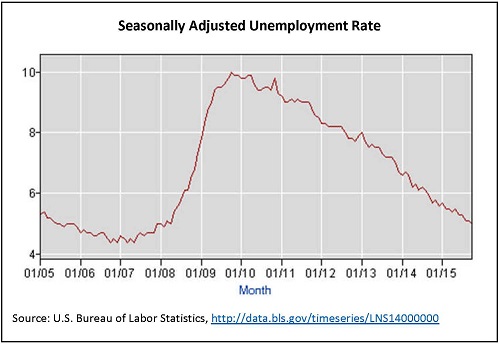A combination of a strong housing market and a solid jobs report has pushed the economy to the next level in the last couple of months. The summer was a great time to be a seller when it came to single-family homes. Prices were up and there was a large pool of interested buyers. Throw in solid jobs reports throughout the year, and the economy had a recipe for success.
 The October jobs report was expected to be good. However, when the numbers were released the news was far better than what many analysts predicted. The economy added 271,000 jobs, nearly 100,000 above the projected 182,000. The news was buoyed by the announcement of a 5% unemployment rate.
The October jobs report was expected to be good. However, when the numbers were released the news was far better than what many analysts predicted. The economy added 271,000 jobs, nearly 100,000 above the projected 182,000. The news was buoyed by the announcement of a 5% unemployment rate.
It’s a rate that hasn’t been seen since back in 2008. Many economists believe that a 5% unemployment rate equates to full employment. After 7 years, the economy appears to be back on track and has nearly recovered.
Additionally, wages increased at the fastest rate since 2009 when the economic downturn was fully taking hold. Hourly wages jumped 0.4% from September to October, or 2.5% compared to October 2014. The jump was the largest year-over-year growth since the start of the Great Recession.
The housing market had plenty of happy news to share as well. The Housing Market Index (HMI), a metric of homebuilder confidence from the National Association of Homebuilders (NAHB) and Wells Fargo, was at 64 last month. It’s a solid three-point boost from September and two points above expectations. Any number over 50 indicates that more builders view housing market conditions as good than poor, but this is the highest HMI we have seen since back in 2005. October capped 5 straight months of steady or improving confidence. It’s one more reason to celebrate the economy’s recovery.
Not every indicator has been positive though. The labor force participation rate held steady at 62.4% in October—its lowest point in 38 years.
The Consumer Confidence Index dipped in October to 97.6 from September’s 102.6. Other statistics such as the present situation index and the expectations index dropped too, signifying that consumers are not as hopeful about the current markets and the short-term outlook. But more consumers in the survey are considering buying a house in the next 6 months, a jump from 5.8% to 6.3% from September to October.
On the commercial real estate side, more economists are growing concerned about the quick rise in prices. The jump could signal a coming bubble. Interest rates are at historic lows, and investors buying now for big returns could end up with big headaches instead if interest rates are raised.
“When the number of cranes observed on a short walk in a city such as Boston reaches double digits, as is the case today, it is worth reflecting on the sustainability of such growth,” said Ed Rosengren, president of the Federal Reserve Bank of Boston (Boston Fed).
Overall, the economy and the housing market have had a great year in 2015. As we enter the final months of the year, it will be interesting to see if the momentum will continue and whether the Fed will raise interest rates at its next meeting in December. Do you see 2015 ending on a high note? Leave your thoughts in the comments.






Recent Comments